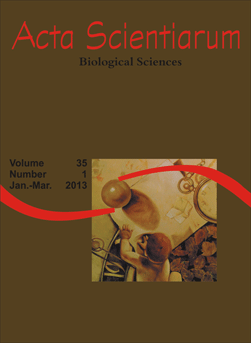<b>Genetic relationship among <i>Camponotus rufipes</i> Fabricius (Hymenoptera: Formicidae) nests by RAPD molecular markers</b> - doi: 10.4025/actascibiolsci.v35i1.10913
Abstract
Random amplified polymorphic DNA (RAPD) markers were used to investigate the genetic relationship among nests of the carpenter ant, Camponotus rufipes, located in the same area. Five random oligodecamers were used to amplify DNA from 108 ant workers collected from six nests. A total of 47 RAPD markers were identified, which revealed low levels of genetic differentiation among nests (Fst = 0.00218) and a low average Shannon index (0.3727) among workers within nests. These results together suggest that the C. rufipes nest may be formed by a single, once-mated queen and that nests produced by queens that are genetically related tend to keep their nests in close proximity to one other.
Downloads
DECLARATION OF ORIGINALITY AND COPYRIGHTS
I Declare that current article is original and has not been submitted for publication, in part or in whole, to any other national or international journal.
The copyrights belong exclusively to the authors. Published content is licensed under Creative Commons Attribution 4.0 (CC BY 4.0) guidelines, which allows sharing (copy and distribution of the material in any medium or format) and adaptation (remix, transform, and build upon the material) for any purpose, even commercially, under the terms of attribution.
Read this link for further information on how to use CC BY 4.0 properly.












1.png)




3.png)













